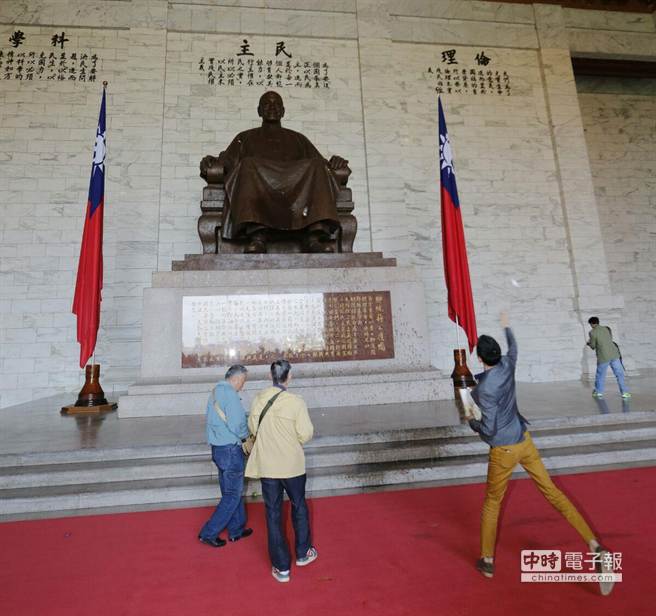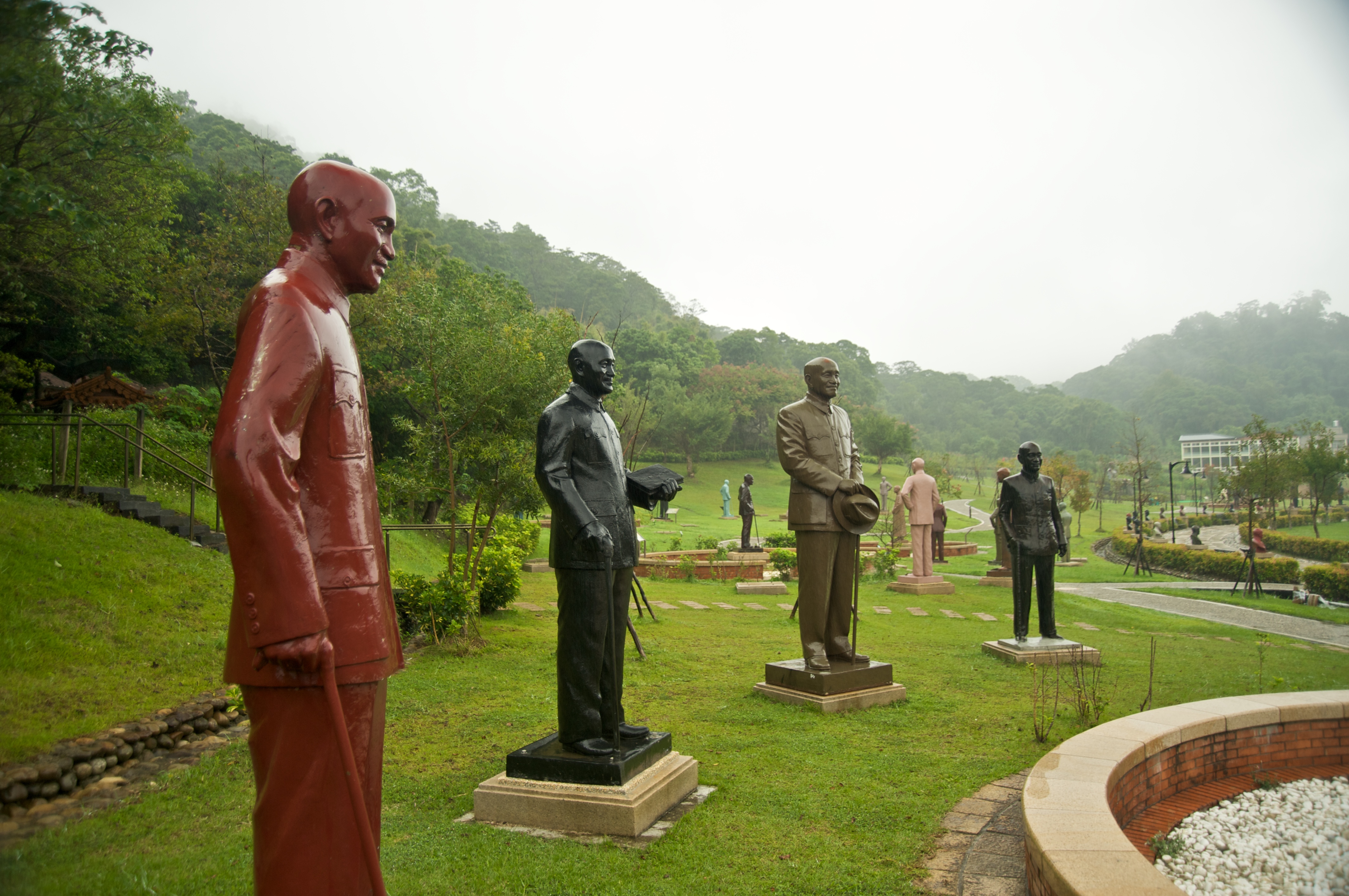Recent Iconoclasm Against Chiang Kai-Shek, The Past Year of Iconoclasm, and the Struggle Over Taiwanese History
by Brian Hioe
語言:
English
Photo Credit: Wu Cheng-feng/Taipei Times, Chang Ching-ya/Taipei Times
Recent Defacements of Chiang Kai-Shek Statues
WHILE IT IS taught in history textbooks in Taiwan that Sun Yat-Sen is the “founding father” of Taiwan—despite his having never been to Taiwan itself—it would be more accurate to say that true “founding father” of Taiwan is Chiang Kai-Shek. When, in reaction to the recent spate of defacing of Chiang Kai-Shek statues in recent weeks, KMT legislator Alex Tsai states that without Chiang Kai-Shek, there would be no Taiwan, this is actually not incorrect. Without Chiang Kai-Shek and the KMT at which he stood at the head, certainly Taiwan would have never passed through the history of White Terror and martial law up until the present. Thus, it is in fact quite true to say that without Chiang Kai-Shek there would be no Taiwan—or “Republic of China”, anyway. Chiang Kai-Shek’s legacy has been instrumental in shaping Taiwanese history in the present, so far as the legacies of Taiwan’s past history of authoritarianism persist and remain to be swept away.
Recent weeks have seen defacements of Chiang Kai-Shek statues in Taipei, Taichung, Taoyuan, Keelung, Tainan, and other metropolitan areas. With recent backlash against Chiang Kai-Shek statues, Keelung Mayor Lin Yu-chang would announce on Monday that the city plans to remove Chiang Kai-Shek statues from schools at a memorial service for the 228 Massacre. Keelung, of course, was one of the sites of heaviest bloodshed during the 228 Massacre. This comes after Tainan Mayor William Lai also suggested during a memorial speech for the 228 Massacre that Tainan would also remove statues of Chiang Kai-Shek from school campuses.
Namely, Chiang Kai-Shek statues are to be found all over Taiwan, so far as part of the “official history” of Taiwan mandated by state education, Chiang Kai-Shek is the heroic founder of the Republic of China whom Taiwanese citizenry should hail as an embodiment of patriotic and civic virtue. But what this flags for us is that the recent campaign of defacements of Chiang Kai- Shek statues across Taiwan, more or less in the period surrounding the yearly commemoration of the 228 Massacre in 1947, is a struggle over history.
 Activists from Taiwan Republic pelting the statue of Chiang at the Chiang Kai-Shek Memorial with eggs. Photo credit: 陳振堂/China Times
Activists from Taiwan Republic pelting the statue of Chiang at the Chiang Kai-Shek Memorial with eggs. Photo credit: 陳振堂/China Times
Actually, the recent spate of defacements of Chiang Kai-Shek statues is nothing new. In truth, defacement of Chiang Kai-Shek statues is an event which happens yearly in Taiwan. Namely, so far as Chiang Kai-Shek statues are found on high school and college campuses across Taiwan, that makes them an easy target of students. In part, this happens because of yearly upsurges of anti-KMT sentiment, but this is also sometimes is a product of youthful mischief more than anything else. The defacement of Chiang Kai-Shek statues has become something of a ritual amongst Taiwanese students, in the same vein as various “college pranks” have become yearly rituals amongst students in all parts of the world—and these pranks often have little political content, but are just carried out for their own sake.
However, the past year would seem to represent something different. Since March 2014, we live in the changed Taiwan following the Sunflower Movement. Identification with Taiwan is at a high and anti-KMT sentiment runs high as well, following the beating the KMT took in nine-in-one elections. The recent spate of defacement of Chiang Kai-Shek statues would seem to be higher in number and more intense than usual. Likewise, protest this year seems especially aggressive—for example, with the decapitation of a Chiang Kai-Shek statue in Taichung. And where Chiang Kai-Shek statues on high school and college campuses happen every year, it is not every year that the Chiang Kai-Shek Memorial in Taipei comes under assault—as it did this year on 228 when activists from the Taiwan Republic Campaign group pelted the statue of Chiang in the memorial with eggs.
A Past Year of Iconoclasm
CONTROVERSY OVER Chiang Kai-Shek statues extends to last year. 2014 saw a campaign by high school students to remove Chiang Kai-Shek statues from high campuses. The apparent initiator of that campaign, Tung Lie-Wei, a Mainlander Taiwanese from a KMT family, writing in a Chinese language article for New Bloom which I translated into English, cited that he had hoped to respectfully remove Chiang Kai-Shek statues because some Mainlander Taiwanese families literally worshipped Chiang Kai-Shek as a god, per culturally Chinese polytheism regarding the divination of hero figures. To disrespect Chiang Kai-Shek would be to transgress against their god—and might serve to only stoke the flames of Taiwan’s ethnic divisions between Mainlander Taiwanese and native Taiwanese. In part, that Taipei mayor Ko Wen-Je, has emphasized that Chiang statues will remain in Taipei reflects that this remains a sensitive issue between Mainlander Taiwanese and native Taiwanese—Ko has otherwise been happy to express the deep-rooted nature of his Taiwanese identification in, for example, that a member of his family was a victim of the 228 Massacre. But, for better or for ill, the recent trend is towards wholesale iconoclasm against images of Chiang Kai-Shek.
This year’s defacing of Chiang Kai-Shek statues occurs under the auspices of an anti-colonial ethos where the KMT occupation of Taiwan following its military defeat to the CCP is viewed as the colonial occupation of Taiwan by the KMT. Certainly, the ethnic differences within Taiwan between the Mainland Taiwanese that came over with the KMT and native Taiwanese have become more and more blurred as time goes by and a number of the third-generation of Mainlander Taiwanese identify with Taiwan rather than China. That such divisions did not in fact have any important role to play in the Sunflower Movement indicative of how contemporary Taiwanese civic nationalism is far from being founded upon ethno-nationalism. But where the understanding of Taiwan’s history as colonial history has become especially prominent, the defacing of Chiang Kai-Shek statues is seen as dealing a blow against that history.
And, indeed, what those who have called attention to Taiwan’s history of colonialism have broadly sought to do in recent years is to point to the fictive nature of Taiwan’s history as the KMT would have had it during the years of its one-party domination of Taiwan. Last year, for example, also saw the pulling down of a Sun Yat-Sen statue in Tainan by the Alliance of Referendum for Taiwan (AOFRT), led by Tsay Ting-Kuei, in an act of protest regarding the representation of history even as Tsay and other AOFRT members have sometimes downplayed the political nature of the act. Where Chiang Kai-Shek’s legacy stands, after all, in the KMT official history, he is the direct heir of and directly continuous with the legacy of Sun Yat-Sen and to target Sun Yat-Sen was to strike more broadly at the KMT official history whether represented as in Chiang or in Sun.
A Struggle Over History?
WHAT THE CURRENT set of circumstances largely expresses is the ambiguities of Taiwanese history that remain to be cleared up. Following the Chen Shui-Bian presidency and the period of Taiwan in which the DPP held political power in Taiwan, even the KMT has been forced to acknowledge some of its political crimes, particularly the 228 Massacre. Yet apologies have been half-hearted and where the “official history” of Taiwan now as still largely legislated by the KMT must make some allowances for its historical crimes, larger issues of responsibility and transitional justice are still obfuscated. After all, what does it truly mean that apologies are made every year but statues of Chiang Kai-Shek, the responsible party for the 228 Massacre, still remain all over Taiwan? Taiwan’s history remains plagued by ambiguities, falsehoods, and uncertainties—or perhaps it is that Taiwanese history has become characterized by its ambiguous, muddled nature.
As KMT politicians and ideologues would have it, despite “flaws,” the legacy of Chiang Kai-Shek remains, overall, positive. Generally, in the worldview that the KMY legislates, such valorized historical figures as Sun Yat-Sen and Chiang Kai-Shek, form a pantheon of national heroes that the nation’s youth are to look up to admire—even when some, as Sun, had little to do with Taiwan. And uncritical worship of Chiang, as presiding over the pantheon, becomes harder and harder to hold up in face of the inescapability of his historical crimes.
Yet where Chiang stands at the head of the KMT pantheon as a founding father of the KMT and of Taiwan, the KMT cannot undo the worship Chiang Kai-Shek. In particular, that would unspool the logic of its historical raison d’être and the logic by which it remains the legitimate ruler of Taiwan, even as we theoretically live in an era of multiparty democracy. As such, the “official” Taiwanese history has, from the beginning, contained a number of falsehoods which are held up in the face of obvious historical reality. But, actually, what we can point to more broadly is the means by which the “official” Taiwanese history mandated by the KMT state was, from the beginning founded upon a lie—the lie that Taiwan was unquestionably China, and that as such, the KMT was the legitimate ruler of Taiwan.
 The Garden of the Generalissimos at Chiang Kai-Shek’s mausoleum in Daxi District, Taoyuan. Statues of Chiang were removed to the garden outside of Chiang’s mausoleum during the Chen Shui-Bian presidency. Photo credit: Fred Hsu/WikiCommons
The Garden of the Generalissimos at Chiang Kai-Shek’s mausoleum in Daxi District, Taoyuan. Statues of Chiang were removed to the garden outside of Chiang’s mausoleum during the Chen Shui-Bian presidency. Photo credit: Fred Hsu/WikiCommons
What would it mean to clarify that history? What would it mean to correct history and to make it correspond to historical reality rather than to the falsehood constructed by the KMT? And what would that mean to those who continue to believe in the historical simulacra of the KMT rather than actual historical reality? Those are the questions that have been raised in the present. So what we see at present is a struggle over Taiwanese history itself. And in striking against the officially legislated vision of history, as represented by Chiang Kai-Shek’s statuary, Taiwan’s young have put forth that their vision of history is far from the one which is taught to them in history textbooks.



